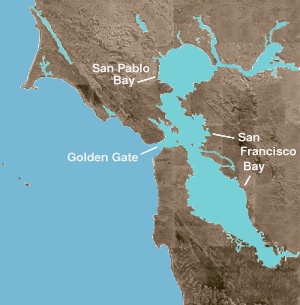Ecology of the San Francisco Estuary

Ecology of the San Francisco Estuary encompasses the complex relationships between the water, land, plant life, and animal species within the San Francisco Bay and its surrounding ecosystems. The estuary is one of the largest on the Pacific Coast of the United States, providing a critical habitat for a diverse range of organisms and playing a vital role in the regional ecosystem.
Overview[edit]
The San Francisco Estuary is formed where the Sacramento River and the San Joaquin River meet and flow into the Pacific Ocean, creating a mix of fresh and salt water that supports a unique and diverse array of life. This area includes not only the San Francisco Bay but also the Delta region, where the rivers converge. The estuary is a key component of the California coastal ecosystem, influencing water quality, sediment transport, and the distribution of plant and animal species.
Habitats[edit]
The estuary's habitats are varied, including tidal marshes, mudflats, subtidal zones, and riparian zones. Each of these habitats supports different communities of organisms.
Tidal Marshes[edit]
Tidal marshes are among the most productive ecosystems in the world, providing breeding grounds, food, and shelter for a multitude of species. They act as crucial buffers, absorbing storm surges and filtering pollutants from the water.
Mudflats[edit]
Mudflats are exposed at low tide, revealing nutrient-rich sediments that sustain a variety of invertebrates, which in turn support larger predators, including birds and fish.
Subtidal Zones[edit]
The subtidal zones are always underwater, even at low tide, and are home to seagrasses, algae, and a variety of fish and invertebrate species.
Riparian Zones[edit]
Riparian zones are the interfaces between land and a river or stream. These areas are critical for maintaining water quality and providing habitat for terrestrial and aquatic species.
Biodiversity[edit]
The San Francisco Estuary is known for its high biodiversity. It is home to over 500 species of fish, birds, and other wildlife, including several endangered species such as the California clapper rail, the salt marsh harvest mouse, and the Chinook salmon.
Conservation Efforts[edit]
Conservation efforts in the San Francisco Estuary focus on restoring habitats, improving water quality, and protecting endangered species. Projects include the restoration of tidal marshes, the reduction of pollutants entering the estuary, and the management of invasive species that threaten the native ecosystems.
Challenges[edit]
The ecology of the San Francisco Estuary faces numerous challenges, including pollution, habitat loss, climate change, and the impact of invasive species. Addressing these challenges requires coordinated efforts among government agencies, non-profit organizations, and the community.
Conclusion[edit]
The San Francisco Estuary is a vital part of California's natural heritage, supporting a rich diversity of life and providing essential ecosystem services. Protecting and restoring this valuable resource is crucial for the health of the region's ecosystems and the well-being of its human communities.

This article is a environment-related stub. You can help WikiMD by expanding it!
Ad. Transform your life with W8MD's Budget GLP-1 injections from $75


W8MD offers a medical weight loss program to lose weight in Philadelphia. Our physician-supervised medical weight loss provides:
- Weight loss injections in NYC (generic and brand names):
- Zepbound / Mounjaro, Wegovy / Ozempic, Saxenda
- Most insurances accepted or discounted self-pay rates. We will obtain insurance prior authorizations if needed.
- Generic GLP1 weight loss injections from $75 for the starting dose.
- Also offer prescription weight loss medications including Phentermine, Qsymia, Diethylpropion, Contrave etc.
NYC weight loss doctor appointmentsNYC weight loss doctor appointments
Start your NYC weight loss journey today at our NYC medical weight loss and Philadelphia medical weight loss clinics.
- Call 718-946-5500 to lose weight in NYC or for medical weight loss in Philadelphia 215-676-2334.
- Tags:NYC medical weight loss, Philadelphia lose weight Zepbound NYC, Budget GLP1 weight loss injections, Wegovy Philadelphia, Wegovy NYC, Philadelphia medical weight loss, Brookly weight loss and Wegovy NYC
|
WikiMD's Wellness Encyclopedia |
| Let Food Be Thy Medicine Medicine Thy Food - Hippocrates |
Medical Disclaimer: WikiMD is not a substitute for professional medical advice. The information on WikiMD is provided as an information resource only, may be incorrect, outdated or misleading, and is not to be used or relied on for any diagnostic or treatment purposes. Please consult your health care provider before making any healthcare decisions or for guidance about a specific medical condition. WikiMD expressly disclaims responsibility, and shall have no liability, for any damages, loss, injury, or liability whatsoever suffered as a result of your reliance on the information contained in this site. By visiting this site you agree to the foregoing terms and conditions, which may from time to time be changed or supplemented by WikiMD. If you do not agree to the foregoing terms and conditions, you should not enter or use this site. See full disclaimer.
Credits:Most images are courtesy of Wikimedia commons, and templates, categories Wikipedia, licensed under CC BY SA or similar.
Translate this page: - East Asian
中文,
日本,
한국어,
South Asian
हिन्दी,
தமிழ்,
తెలుగు,
Urdu,
ಕನ್ನಡ,
Southeast Asian
Indonesian,
Vietnamese,
Thai,
မြန်မာဘာသာ,
বাংলা
European
español,
Deutsch,
français,
Greek,
português do Brasil,
polski,
română,
русский,
Nederlands,
norsk,
svenska,
suomi,
Italian
Middle Eastern & African
عربى,
Turkish,
Persian,
Hebrew,
Afrikaans,
isiZulu,
Kiswahili,
Other
Bulgarian,
Hungarian,
Czech,
Swedish,
മലയാളം,
मराठी,
ਪੰਜਾਬੀ,
ગુજરાતી,
Portuguese,
Ukrainian